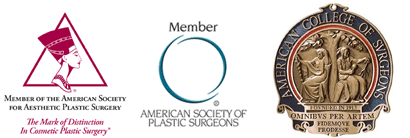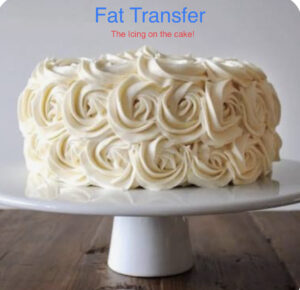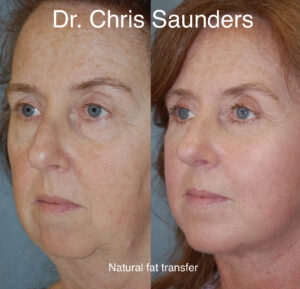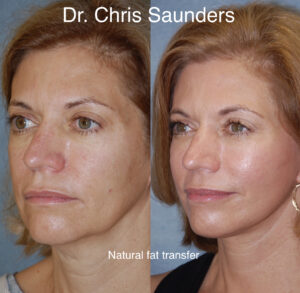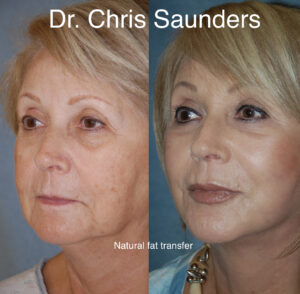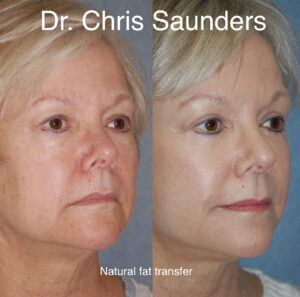The ICING ON THE CAKE : An Overview
Fat transfer is like the “ICING ON THE CAKE.” The transfer of fat is one fantastic method (of many methods) that are used as part of facial rejuvenation. If we are trying to look younger, healthier, and more attractive, it is important to learn about your options. Different ways or methods are available to help us accomplish these goals. Facial rejuvenation involves Med Spa treatments, injections, Botox, and/or surgery. Classic cosmetic operations are facelifts, neck lifts, and eye tucks. My specialty operation is my LAVVNDR Lift. It is a trilaminar, composite, deep plane facelift. Different techniques are used to get the results we desire. This educational writing will focus on all the ins and outs about fat transfer. It was written at the request of a patient from Philadelphia, PA.
Overview:
Facial fat transfer or fat grafting is the process of taking fat from one part of the body and moving it to the face. By aesthetically or skillfully moving it to areas where it is needed, we can get a more youthful and natural rejuvenation of the face. Fat can also be transferred to the buttock as part of a BBL or to the breasts for breast augmentation. But this writing is for fat moved to the face as part of one’s desires to look younger. The fat is removed from areas that have excess fat, like the hips and stomach locations. Classic areas to place the fat and make us look younger are the cheeks, facial folds, and the lips or jaw line. Healing takes time as the bruising and swelling subsides. Small amounts of fat are extremely successful and have the best results. Large amounts of fat significantly increase risks of looking unnatural.
Fat transfer can be done alone or by itself, without other rejuvenation procedures. It can also be done with surgery like chemical peels, facelifts, or neck lifts. As we age, our tissues descend or drop. Skin gets thinner and weaker. Drooping areas cause jowls, turkey neck, and bags. Multiple factors are involved and contribute to making us look older. In medical talk this is called multifactorial. Fat transfer is just one tool or method that we use to look younger. No one single method can correct aging. For example, peels and lasers can help with aged and weathered skin. Facelifts can elevate and reposition droopy and loose tissue. As we age, we also lose fat. Think of an 80 year old lady. She might be very thin and gaunt in the face because of this fat loss. Transfer will significantly improve this component of aging. It’s extremely successful, and I feel it is a fantastic part of rejuvenation that can not be over looked. It’s like “ICING ON THE CAKE.”. Cake is good. But icing makes it better!
The EYE LID CHEEK JUNCTION is one fantastic location where fat will help us look younger. This area descends amd makes the bags and circles more prominemt. Fat can be used with other techniques to give us a natural and more healthy rejuvenation. By elevating and lifting this junction area to a more normal and youthful location, we can really look more rejuvenated in this important location. If we don’t like “Looking TIRED” in the eyes, this method can be wonderful to cosmetically improve it. For those interested in this topic in more detail, you can read a writing devoted to this topic, and you can link there now.
How is it Done?
Fat is “harvested” or taken from areas of excess fat. This is done with a process very much like liposuction. The main difference is that liposuction removes lots of fat. Harvesting fat for transfer typically means removing small or natural amounts of fat. This is because rejuvenation doesn’t require large amounts, but smaller volumes. Large fat transfer to the face just makes us fake looking and unnatural. Artistic facial rejuvenation doesn’t use large volumes of fat but smaller and more skillfully placed fat.
The fat is then processed. This is when fat is centrifuged or spun to separate it into different layers. The top and bottom layers, after centrifugation, are thrown away. The middle layer has almost pure fat, and this is what is used. The fat is then placed in small syringes and small needles are used to inject it. It is then transferred or grafted to areas where it is needed.
Recovery:
The recovery is very easy, in my opinion. There is extremely little pain. Most patients take no pain medication at all. Bruising and swelling are typical, however. It takes time for this to resolve. Plan on a week or two for a large amount of the swelling to go away, but even longer to get to the final result. It’s common to initially feel that it’s too much fat because of this swelling. Almost everyone will feel like this because the swelling coupled with the fat makes it appear extra big. After the swelling resolves, we typically are left with natural and youthful rejuvenation.
Risks:
The risks of fat transfer are very low. Lumpy results are extremely low with proper techniques. I believe that lumpy results mainly come from doing too much volume, which is aesthetically poor anyway. Fat transfer to the eyelids has to be extremely careful, because the skin is so thin. The transfer should be limited to the “tear trough” area and is not appropriate for the entire “circle” around the aging eyes. Bags and circles are best treated with an eye tuck or blepharoplasty. Fat transfer can be done to compliment the surgery or to give more rejuvenation, but not to replace eyelid surgery.
Absorption of the fat means that some will go away during the healing process. Fat transfer almost always has some degree of fat that is ”lost” or goes away. It’s actually normal and a small percentage will resorb. Some doctors will place larger and larger amounts of fat to compensate for this loss. The rationale is that if some fat will go away, then let’s do more volume, so more will stay after the resorption. It sounds logical, but it violates the basic physiology of fat grafting. It needs blood supply to live. More fat just decreases the amount of blood for the fat at the cellular level, and this INCREASES fat loss. The best and latest techniques use natural amounts so most of the fat lives; and we don’t get a lot of absorption, and lumps are extremely rare.
Results:
Natural rejuvenation with high satisfaction is a typical result after this procedure. Like all cosmetic surgery, patients should expect improvement and have REALISTIC EXPECTATIONS. These treatments don’t make us look like a Movie Star or an Instagram model, they make us a younger version of who we are. The treatments IMPROVE aging; they don’t eliminate aging. Having realistic expectations is a critical concept for all cosmetic and plastic surgery.
Results can last years and in many cases even longer. Nothing is permanent. Compared to a twin sister, you might look younger for the rest of your life. But aging continues, and it my have to be repeated. Some people may desire a “touch up” or another boost of rejuvenation.
Summary:
As we age, multiple things happen to make us look younger. Loss of facial fat is one of the main processes that contribute to this aging. By taking fat from others areas like the love handles, we can transfer it to areas where it is needed to look younger. The process is done with small needles that leave no scars. Recovery is relatively quick, but time has to be slotted for resolution of bruising and swelling. Some loss of fat called absorption will occur, but it’s usually minimal and not a big factor. Rejuvenation and enhancement of the EYELID CHEEK JUNCTION is one location that I have found can really make us look younger, more beautiful, and still natural. Results and satisfaction tend to be extremely high. Nothing lasts forever, and additional transfer or other cosmetic procedures can be necessary in the future.

